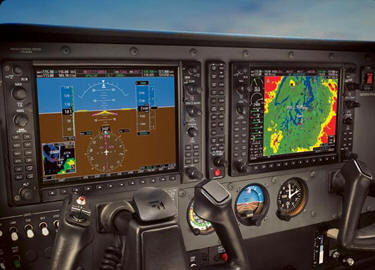 |
|
|
|
|
|
|||
|
By Mike Mitchell (see NTSB Makes Safety Recommendations To The FAA On Glass Cockpits) |
||||
 |
March 11, 2010 -
The National Transportation Safety Board adopted a study concluding that
single engine airplanes equipped with glass cockpits had no better
overall safety record than airplanes with conventional instrumentation.
The safety study,
which was adopted unanimously by the Safety Board, was initiated more
than a year ago to determine if light airplanes equipped with digital
primary flight displays, often referred to as "glass cockpits," were
inherently safer than those equipped with conventional instruments. The study, which looked at the accident rates of over 8,000 small piston-powered airplanes manufactured between 2002 and 2006, found that those equipped with glass cockpits had a higher fatal accident rate then similar aircraft with conventional instruments. |
|||
|
The Safety Board determined that because glass cockpits are both complex
and vary from aircraft to aircraft in function, design and failure
modes, pilots are not always provided with all of the information they
need – both by aircraft manufacturers and the Federal Aviation
Administration – to adequately understand the unique operational and
functional details of the primary flight instruments in their airplanes.
NTSB Chairman Deborah A.P. Hersman highlighted the role that training
plays in preventing accidents involving these airplanes.
Today, nearly all newly manufactured piston-powered light airplanes are
equipped with digital primary flight displays.
And the number of older airplanes being retrofitted with these
systems continues to grow. |
||||
|
Based on
the study findings, the NTSB made six safety recommendations to the FAA:
1. Enhance pilot
knowledge and training requirements;
2. Require
manufacturers to provide pilots with information to better manage system
failures;
3. Incorporate
training elements regarding electronic primary flight displays into
training materials and aeronautical knowledge requirements;
4. Incorporate
training elements regarding electronic primary flight displays into
initial and recurrent flight proficiency requirements for pilots of
small light general aviation airplanes equipped with those systems, that
address variations in equipment design and operations of such displays;
5. Support
equipment-specific pilot training programs by developing guidance for
the use of glass cockpit simulators other than those that are approved
by the FAA as flight training devices; and 6. Inform the general aviation community about the importance of reporting malfunctions or defects with electronic flight, navigation and control systems through the Service Difficulty Reporting system. |
| ©AvStop
Online Magazine
Contact
Us
Return To News
|
|
